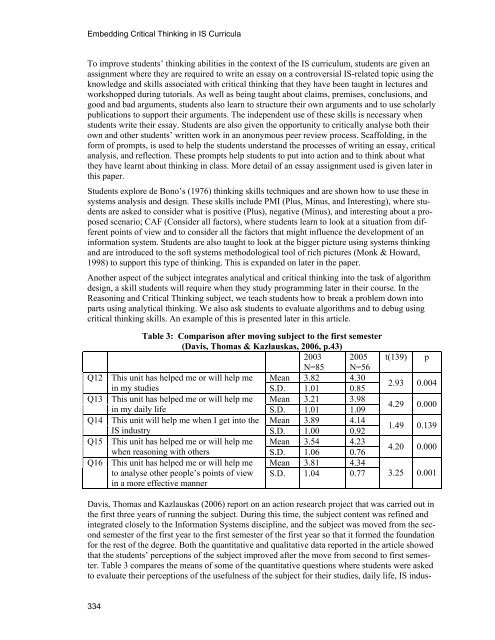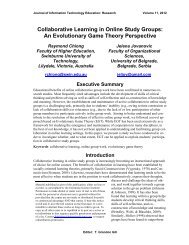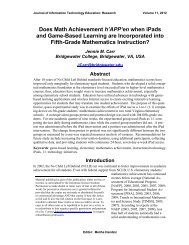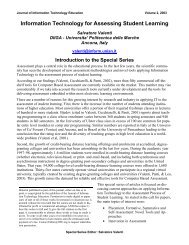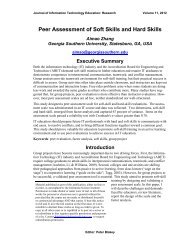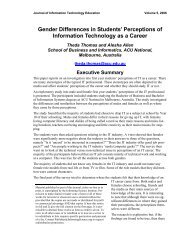Put Title Here Using Heading 1 Style - Journal of Information ...
Put Title Here Using Heading 1 Style - Journal of Information ...
Put Title Here Using Heading 1 Style - Journal of Information ...
Create successful ePaper yourself
Turn your PDF publications into a flip-book with our unique Google optimized e-Paper software.
Embedding Critical Thinking in IS Curricula<br />
To improve students’ thinking abilities in the context <strong>of</strong> the IS curriculum, students are given an<br />
assignment where they are required to write an essay on a controversial IS-related topic using the<br />
knowledge and skills associated with critical thinking that they have been taught in lectures and<br />
workshopped during tutorials. As well as being taught about claims, premises, conclusions, and<br />
good and bad arguments, students also learn to structure their own arguments and to use scholarly<br />
publications to support their arguments. The independent use <strong>of</strong> these skills is necessary when<br />
students write their essay. Students are also given the opportunity to critically analyse both their<br />
own and other students’ written work in an anonymous peer review process. Scaffolding, in the<br />
form <strong>of</strong> prompts, is used to help the students understand the processes <strong>of</strong> writing an essay, critical<br />
analysis, and reflection. These prompts help students to put into action and to think about what<br />
they have learnt about thinking in class. More detail <strong>of</strong> an essay assignment used is given later in<br />
this paper.<br />
Students explore de Bono’s (1976) thinking skills techniques and are shown how to use these in<br />
systems analysis and design. These skills include PMI (Plus, Minus, and Interesting), where students<br />
are asked to consider what is positive (Plus), negative (Minus), and interesting about a proposed<br />
scenario; CAF (Consider all factors), where students learn to look at a situation from different<br />
points <strong>of</strong> view and to consider all the factors that might influence the development <strong>of</strong> an<br />
information system. Students are also taught to look at the bigger picture using systems thinking<br />
and are introduced to the s<strong>of</strong>t systems methodological tool <strong>of</strong> rich pictures (Monk & Howard,<br />
1998) to support this type <strong>of</strong> thinking. This is expanded on later in the paper.<br />
Another aspect <strong>of</strong> the subject integrates analytical and critical thinking into the task <strong>of</strong> algorithm<br />
design, a skill students will require when they study programming later in their course. In the<br />
Reasoning and Critical Thinking subject, we teach students how to break a problem down into<br />
parts using analytical thinking. We also ask students to evaluate algorithms and to debug using<br />
critical thinking skills. An example <strong>of</strong> this is presented later in this article.<br />
Table 3: Comparison after moving subject to the first semester<br />
(Davis, Thomas & Kazlauskas, 2006, p.43)<br />
2003 2005 t(139) p<br />
N=85 N=56<br />
Q12 This unit has helped me or will help me<br />
in my studies<br />
Mean<br />
S.D.<br />
3.82<br />
1.01<br />
4.30<br />
0.85<br />
2.93 0.004<br />
Q13 This unit has helped me or will help me<br />
in my daily life<br />
Mean<br />
S.D.<br />
3.21<br />
1.01<br />
3.98<br />
1.09<br />
4.29 0.000<br />
Q14 This unit will help me when I get into the<br />
IS industry<br />
Mean<br />
S.D.<br />
3.89<br />
1.00<br />
4.14<br />
0.92<br />
1.49 0.139<br />
Q15 This unit has helped me or will help me<br />
when reasoning with others<br />
Mean<br />
S.D.<br />
3.54<br />
1.06<br />
4.23<br />
0.76<br />
4.20 0.000<br />
Q16 This unit has helped me or will help me Mean 3.81 4.34<br />
to analyse other people’s points <strong>of</strong> view<br />
in a more effective manner<br />
S.D. 1.04 0.77 3.25 0.001<br />
Davis, Thomas and Kazlauskas (2006) report on an action research project that was carried out in<br />
the first three years <strong>of</strong> running the subject. During this time, the subject content was refined and<br />
integrated closely to the <strong>Information</strong> Systems discipline, and the subject was moved from the second<br />
semester <strong>of</strong> the first year to the first semester <strong>of</strong> the first year so that it formed the foundation<br />
for the rest <strong>of</strong> the degree. Both the quantitative and qualitative data reported in the article showed<br />
that the students’ perceptions <strong>of</strong> the subject improved after the move from second to first semester.<br />
Table 3 compares the means <strong>of</strong> some <strong>of</strong> the quantitative questions where students were asked<br />
to evaluate their perceptions <strong>of</strong> the usefulness <strong>of</strong> the subject for their studies, daily life, IS indus-<br />
334


